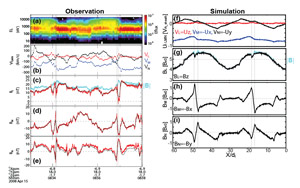
2013 THEMIS SCIENCE NUGGETS
Three-Dimensional Dynamics of Vortex-Induced Reconnection and Comparison with THEMIS Observations
by T.K.M. Nakamura, Los Alamos National Laboratory
Introduction
Along the Earth’s low-latitude magnetopause, strong mixing between solar wind and magnetospheric plasma is frequently observed. A leading candidate for this mixing is the Kelvin-Helmholtz (KH) instability, which is driven by the velocity shear between the solar wind and the magnetosphere. Two-dimensional simulations have shown that KH vortices can compress the pre-existing current layer and drive magnetic reconnection in regions where it would not normally occur. This interplay between KH and reconnection is expected to play an important role in the mixing across the boundary layer. To better understand the physics, we performed the first 3D fully kinetic simulation of this process and compared the results with THEMIS observations at the magnetopause.
| Figure 1. A time-series of the current density |J| in the X-Y plane and sample magnetic field lines around flux ropes formed along the vortex edge. |
Results
In this simulation, the velocity shear coexists with the magnetic shear within a boundary layer as generally seen at the magnetopause. The size of the vortex is set to be λKH = 30di (di: the ion inertial length), which is close to the observed values. To minimize the effects of simulation boundaries, the domain size for this simulation is set to be larger than λKH in both directions with LX × LY × LZ = 2λKH × 1.3λKH × λKH. Fig.1 shows the simulation result at five time slices. As the vortex develops, the current (magnetic shear) layer is compressed at the edge of the vortex. Next, the tearing instability leads to the formation of multiple flux ropes along the compressed layer and the development of three-dimensional magnetic reconnection at multiple points (see Fig.1a). These flux ropes modify the connectivity of field lines across the vortex and lead to more efficient 3D mixing of plasma than observed in previous 2D simulations. As the simulation proceeds, the flux ropes propagate with the flow and eventually merge with the vortex (see Fig.1b-e).
| Figure 2. Left panels show THEMIS data of (a) ion energy-time spectrogram and (b) the ion velocity, and (c–e) magnetic field components. Right panels show plots of (f) velocity and (g–i) magnetic field components along a dotted line in Fig.1a. |
Next, we show a KH vortex event observed by THEMIS-C. The left panels of Fig. 2 show five minutes of data during 08:33-08:38 UT on 15 April 2008. Around this interval, THEMIS-C crossed the low-latitude magnetopause and encountered quasi-periodic plasma and magnetic field fluctuations, which are typically interpreted as KH waves. Clear signatures of flux ropes including bipolar BN were observed between the KH waves (see vertical lines), with features similar to the simulation results (see right panels). Interestingly, the patterns of velocity and magnetic field fluctuations are largely consistent between observation and simulation; periodic +/- VN fluctuation are accompanied with periodic long VM dips, and the bipolar BN variations are correlated with these VN,M variations. Furthermore, the size of the flux ropes relative to the vortex dimension is also similar between observation and simulation. In particular, the ratio between each peak-to-peak time interval of observed BN variations and the KH period was ΔTpeak/ΔTKH~0.03, which is close to the most commonly observed ratio from the simulations.
Conclusion
Three-dimensional fully kinetic simulations relevant to the lower-latitude magnetopause predict that multiple small-scale flux ropes are produced along the perimeter of KH vortices. These flux ropes alter the connectivity of magnetic field lines and increase the efficiency of mixing across the magnetopause boundary. Observations from THEMIS show features consistent with these predictions, including the location and size of these flux ropes relative to the parent vortex.
Reference
Nakamura, T. K. M., W. Daughton, H. Karimabadi, and S. Eriksson, Three-dimensional dynamics of vortex-induced reconnection and comparison with THEMIS observations, J. Geophys. Res., 118, 5742-5757, doi:10.1002/jgra.50547Biographical Note
Takuma Nakamura is a postdoctoral scholar at the Plasma Physics Group in the Computational Physics Division, the Los Alamos National Laboratory. His recent research includes magneto-hydrodynamic and kinetic simulations as well as spacecraft observations regarding plasma transport and mixing, turbulence, and magnetic reconnection.
 Please send comments/suggestions to
Emmanuel Masongsong / emasongsong @ igpp.ucla.edu
Please send comments/suggestions to
Emmanuel Masongsong / emasongsong @ igpp.ucla.edu


